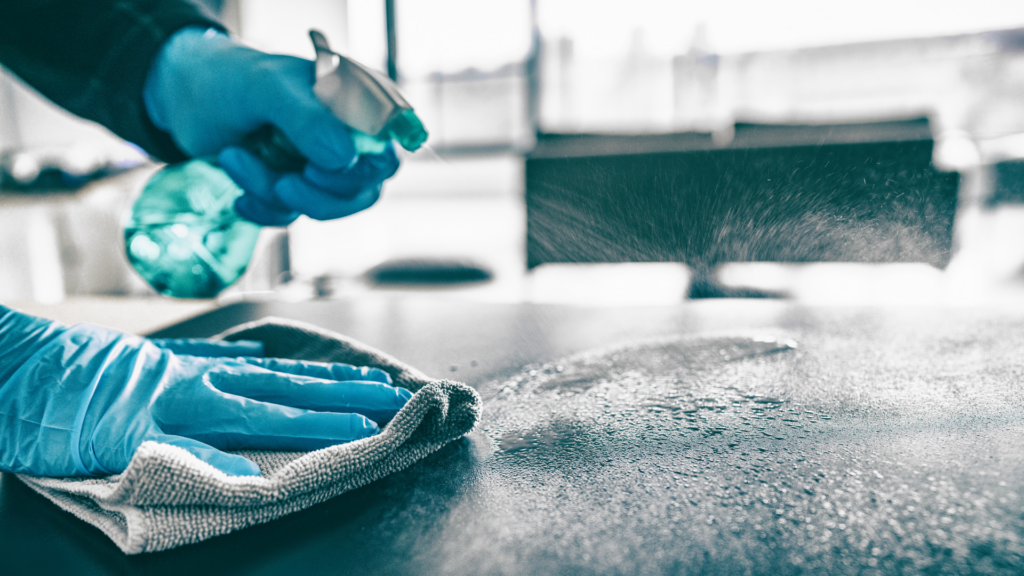In a world where cleanliness is paramount, understanding how to put the five stages of cleaning and disinfection has never been more critical.
So, if you’re ready to up your cleaning game and ensure a healthier environment, stick around. You’re about to discover a world of cleanliness that goes beyond the surface.
Put the Five Stages of Cleaning and Disinfection
Maintaining a clean and sanitized environment stands crucial in safeguarding health. Let’s delve into how cleaning precedes disinfection, and learn about the profound five stages that simplify this process.
 Overview of the Five Stages
Overview of the Five Stages
Let’s take a closer look and put the five stages of cleaning and disinfection into perspective:
- Clearing the Area: Removing clutter paves the way for thorough cleaning. It’s like clearing a stage before starting a performance.
- General Cleaning: With the area clear, general cleaning commences. Think of it as sweeping a floor before mopping it.
- Targeted Cleaning: This stage takes care of persistent stains and spots. This reminds one of an artist refining a painting detail.
- Rinse: After applying detergents and cleaning solutions, rinsing ensures no residue remains. This stage is similar to a chef cleaning a counter before starting to cook.
- Disinfection: With a squeaky clean surface, disinfectants can now effectively tackle germs. Imagine inserting a key into a well-oiled lock; it turns smoothly without any resistance.
Through these stages, one can establish a routine that ensures cleanliness goes beyond mere appearance. It’s not about doing the minimum but committing to a process that maintains environmental health, and ultimately, individual health. These five-stage processes provide a comprehensive approach, ensuring every nook and cranny is clean and disinfected.
The Role of PPE in Cleaning and Disinfection
Transcending the stages of cleaning and disinfection, the application of personal protective equipment (PPE) constitutes an integral step. PPE shields users from potential hazards, serving as the individual’s first line of defense.
Choosing the Right PPE
Identifying the correct PPE for a job involves analyzing the task at hand, considering potential risks, and determining the suitable safety measure. For instance, a cleaning crew dealing with industrial spills may require chemical-resistant gloves and eye protection, while housekeeping staff in a hospital setting might need masks, gloves, and protective gowns.
Proper Use and Disposal of PPE
Exploiting the full potential of PPE relies not only on its selection but also its fitting, use, and disposal. The assembly of PPE involves a particular order, for instance, donning gloves last after mask and protective gown. Removing PPE must happen in a manner that restricts exposure to contamination, typically a sequential process known as doffing.
Maintaining Cleanliness and Preventing Recontamination
As a natural extension of the previous discussion, the focus now shifts to maintaining cleanliness and preventing recontamination post-disinfection process. Demonstrating the sequential connection from the preceding stages, this phase serves as an important capping step in the five stages of the cleaning and disinfection process.
Regular Cleaning Schedules
Implementing regular cleaning schedules forms a crucial link in ensuring a contamination-free environment. It maintains a high level of hygiene and wards off potential disease-causing agents. For example, in healthcare settings, maintaining a thoroughly sanitized environment can help prevent the potential spread of diseases like MRSA or C. difficile. Enforcing cleaning schedules, whether daily, weekly, or monthly, based on the needs of the institution, is highly recommended, according to the CDC guidelines.
Safe Storage of Cleaning Supplies
Accompanying the regular cleaning is the safe storage of cleaning supplies. It plays a vital role in preventing accidental exposure to harmful substances or potential misuse. Cleaning supplies, including detergents and disinfectants, should be stored in well-ventilated, dry areas, away from any food or water supply.
Must Know
So, we’ve journeyed through and put the five stages of cleaning and disinfection. It’s clear that pre-cleaning, using quality detergents, and thorough rinsing pave the way for effective disinfection. We’ve also seen the vital role PPE plays in protecting those who keep our spaces clean. Remember, the battle against contamination doesn’t end with disinfection. Maintaining cleanliness and preventing recontamination are just as vital. Regular cleaning schedules and safe storage of cleaning supplies are not to be overlooked.
